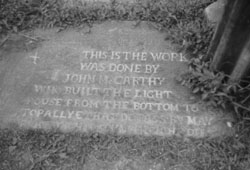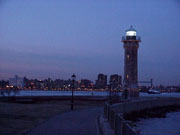
Lighthouse
Landmarks Main > Lighthouse
On
November 25, 1975, the Landmarks Preservation Commission held a public
hearing on the proposed designation as a Landmark of the Lighthouse and
the proposed designation of the related Landmark Site. The hearing has
been duly advertised in accordance with the provisions of law. Three witnesses
spoke in favor of designation. There were no speakers in opposition to
designation. The representatives of the Roosevelt Island Development Corporation
have agreed to the designation.
Description and Analysis
This small lighthouse stands at the northern tip of Roosevelt Island on a projection of land which was at one time a tine separate island connect connected to the main one by a wooden bridge. Local legend maintains that during the 19th century a patient from the nearby Lunatic Asylum was permitted to build a stone fort on this outcropping since he feared an invasion by the British. When plans were formulated to build the lighthouse, this patient allegedly was persuaded to surrender the fort only AFTER much cajoling and a bribe of bogus money. The tale continues that the patient himself demolished the fort and built the new lighthouse, carving the inscription:
 This
is the work Was done by John McCarthy
This
is the work Was done by John McCarthy
Who built the Light House from he bottom to the Top
All ye who do pass by may Pray for his soul when he dies.
While construction of the lighthouse cannot actually be credited to the diligent Mr. Mc Carthy, the warden of the Lunatic Asylum did specially mention in his annual report of 1870 an "industrious bur eccentric" patient who had built near the Asylum a large section of seawall, thereby reclaiming a sizable piece o f land. The warden further remarked that this patient "is very assiduous, and seems proud of his work, and he has reason to be, for it is a fine structure, strong and well built." Whether or not this patient was the model for the legendary for the fort and lighthouse builder, the connection of the lighthouse and the Lunatic Asylum is an historical fact. In May 1872, City official resolved to "effectually light" the Asylum and the tip of the island. The following September, the lighthouse was completed , with lamps furnished by the U.S. Lighthouse Service. The stone structure was built under the direction of the Board of Governors of the Commission of Charities and Correction, the body which administered the numerous City institutions on the island., At that time. The supervising architect for this Commission was James Renwick, Jr.
ames Renwick, Jr. (1818-1895), was son of a highly regarded professor at Columbia College, began his notable career in 1836 as an engineer supervising the construction of the great Distributing Reservoir at 42nd Street of the Croton water supply system. With the selection on 1840 of his competition drawings for Grace Church, at that time New York's wealthiest and most fashionable congregation, Renwick, then only twenty-five and entirely self-trained as an architect achieved instant recognition. During his long and highly successful career he designed many important buildings, including the Smithsonian Institution in Washington, DC, a building at Vasser College in Poughkeepsie, the William E. Dodge Villa (now Greyston Conference Center) and St. Patrick's Cathedral-both designated landmarks, as is Grace Church. An art collector and yachtsman, Renwick's association with the Charities and Corrections Board, must, to a certain degree, have had philanthropic motivations, He designed the Workhouse, City Hospital and Smallpox Hospital on Blackwell's Island (as Roosevelt Island was then known); the Inebriate and Lunatic Asylum on Ward's Island; and the main building of the Children's Hospital on Randall's Island . as well as several smaller structures, among them the lighthouse on Roosevelt Island.
The lighthouse is approximately fifty feet tall and is constructed of
rock-faced, random gray ashlar. The stone (gray gneiss) was quarried on
the island itself, predominately by convict labor from the Penitentiary
on the island, and was used for many of the institutional buildings erected
there. The lighthouse is encircled by a small yard paved with flagstone.
An entry walk at the south is flanked by stone bollards which have pyramidal
tops carved with simple trefoils. The lighthouse is octagonal in plan
and vertically organized according to the tripartite division of the classical
column-base, shaft and  capital.
The base is separated from the superstructure by a series of simple moldings
which are interrupted to the south side by a projecting gable above the
single entrance doorway. This doorway, which an incised pointed arch above
a splayed keystone with flanking corbels, is designed in a rustic version
of the Gothic style. The stepped stones of the lighthouse is pierced above
the doorway by two slit windows which light the interior staircase. The
top of the shaft is adorned with Gothic foliate ornament in high relief,
separated by simple moldings from the brackets which support the observation
platform. These elements form the crowning feature of the lighthouse.
The octagonal lantern, originally surmounted by a picturesque conical
roof is of glass and steel and is surrounded by a simple metal railing.
capital.
The base is separated from the superstructure by a series of simple moldings
which are interrupted to the south side by a projecting gable above the
single entrance doorway. This doorway, which an incised pointed arch above
a splayed keystone with flanking corbels, is designed in a rustic version
of the Gothic style. The stepped stones of the lighthouse is pierced above
the doorway by two slit windows which light the interior staircase. The
top of the shaft is adorned with Gothic foliate ornament in high relief,
separated by simple moldings from the brackets which support the observation
platform. These elements form the crowning feature of the lighthouse.
The octagonal lantern, originally surmounted by a picturesque conical
roof is of glass and steel and is surrounded by a simple metal railing.
The rock-faced stone and the sparing uses of boldly scaled ornamental detail give the lighthouse the strength and character of a medieval fortification. In its isolated setting the lighthouse is a prominent and dramatic feature of Roosevelt Island.